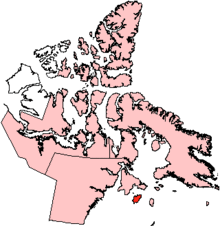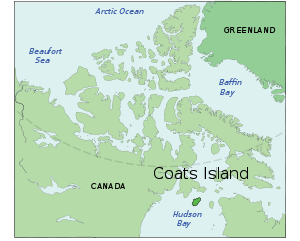- Coats Island
-
Coats Island Native name: Akpatordjuark 
Coats Island, Nunavut
Geography Location Hudson Bay Coordinates 62°35′N 082°45′W / 62.583°N 82.75°WCoordinates: 62°35′N 082°45′W / 62.583°N 82.75°W Area 5,498 km2 (2,122.8 sq mi) Highest point 185 m (607 ft) Country Nunavut  Nunavut
NunavutRegion Kivalliq Demographics Population Uninhabited Coats Island (Inuktitut: Akpatordjuark[1]) lies at the northern end of Hudson Bay in the Kivalliq Region of Nunavut. At 5,498 km2 (2,123 sq mi) in size, it is the 107th largest island in the world, and Canada's 24th largest island.
The island has areas of federal crown land and areas of private land owned by Inuit, however, the last permanent residents left in the 1970s.[2] With no permanent settlements, the island is also the largest uninhabited island in the northern hemisphere south of the Arctic Circle. It was the last home of the Sadlermiut people who are widely believed to represent the Dorset culture.
Contents
Geography
Coats Island is 130 km (81 mi) long. It reaches a maximum elevation of 185 m above sea level. This high point occurs along the rocky northern perimeter between Cape Pembroke and Cape Prefontaine. The underlying rocks in this area are Precambrian metamorphics. Less than 5% of the island is more than 100 m (330 ft) above sea level. The southern half of the island is primarily low-lying muskeg and made up of Palaeozoic sedimentary rocks, such as limestone and sandstone.
Fauna
Since 1920, Coats Island has been designated a reindeer reserve. After caribou were extirpated from nearby Southampton Island, the Coats herd was used to reestablish the Southampton herd. It is also known for its population of thick-billed murre. Two colonies of 30,000 birds occur along the cliffs at the rocky northern end. There are also significant concentrations of walrus at walrus haulouts at the base of cliffs or on offshore islands at the northern end of the island (one each at Cape Pembroke and Cape Prefontaine). These are visited regularly by Inuit from the hamlet at Coral Harbour, on Southampton Island, for harvesting.
Cape Pembroke is an Important Bird Area.
History
The first recorded sighting of Coats Island was by Thomas Button in 1612; he explored it further the following year.[3] It received its name from William Coats, a sea captain for the Hudson's Bay Company. He visited the area periodically between 1727 and 1751.
In 1824, HMS Griper, under Captain George Francis Lyon, anchored off Cape Pembroke on Coats Island. The whalers then discovered a band of "Eskimos" who were said to have spoken a "strange dialect" and were called Sadlermiut.[4] Since then, the Sadlermiut continued to establish contact with Westerners. However, as with many North American aboriginals, the Sadlermiut were often susceptible to Western diseases.
The area was confirmed to be an island by American whalers, who began visiting the area in the 1860s. By 1896, there were only 70 of Sadlermiut remaining. Then, in the fall of 1902, the British trading/whaling[5] vessel named the Active had made a stop at Cape Low,[6] Southampton Island. It is said that some of the Sadlermiut caught a disease, possibly an influenza,[7] typhoid or typhus, from a sick sailor aboard the Active, which then spread to the entire community.[8][4] By winter 1902-03, the entire Sadlermiut population had died as a result.[9][5]
A Hudson's Bay Company trading post was maintained on the island from August 1920 to August 1924, and a number of Inuit families lived on the island during that period, some of whom had been brought from Baffin Island on boats. In 1921, an overturned fisherman's dory covering two skeletons was found by Capt. George Cleveland on Coats Island which were alleged to be the remains of Captain Arthur Gibbons and one of his officers, survivors of the wreck of the American whaling schooner A. T. Gifford.[10] The Canadian Government held a criminal investigation.[11]
References
- ^ "Renaming the North". Akpatordjuark. http://explorenorth.com/library/weekly/aa092599.htm. Retrieved 2008-04-18.
- ^ "Coats Island". bsc-eoc.org. http://www.bsc-eoc.org/iba/site.jsp?siteID=NU005. Retrieved 2009-05-05.
- ^ Christy, Miller (1894). The voyages of Captain Luke Foxe of Hull, and Captain Thomas James of Bristol, in search of a northwest passage, in 1631-32; with narratives of the earlier northwest voyages of Frobisher, Davis, Weymouth, Hall, Knight, Hudson, Button, Gibbons, Bylot, Baffin, Hawkridge, and others. London: Hakluyt Society. http://books.google.com/books?id=Vh87AAAAIAAJ&printsec=frontcover&dq=related:STANFORD36105004846502#v=onepage&q&f=false.
- ^ a b "In the bones of the world (Part eight)". Nortext Publishing Corporation (Iqaluit) (Nunatsiaq News). 2002-07-26. http://www.nunatsiaq.com/archives/nunavut020705/news/editorial/columns.html#nunani_july26.
- ^ a b "Aboriginal 7 - Life in Canada". Library and Archives Canada. http://www.collectionscanada.gc.ca/art/050602/0506020222_e.html. Retrieved 2008-03-21.
- ^ Collins, Henry B. (1956). Vanished Mystery Men of Hudson Bay. Vol. CX No. 5. National Geographic Magazine. p. 674.
- ^ Renouf, M.A.P. (Fall 1991). "Museum Notes - Palaeoeskimo in Newfoundland & Labrador". The Rooms. http://www.therooms.ca/museum/mnotes5.asp. Retrieved 2008-03-21.
- ^ "The People Arrive". The Free Library. 1999-03-01. http://www.thefreelibrary.com/The+People+Arrive.(history+of+the+Inuit)-a057040631. Retrieved 2008-03-22.
- ^ Briggs, Jean L.; J. Garth Taylor. "The Canadian Encyclopedia: Sadlermiut Inuit". Historica Foundation of Canada. http://www.encyclopediecanadienne.ca/index.cfm?PgNm=TCE&Params=A1ARTA0007041. Retrieved 2008-03-21.
- ^ Boston Daily Globe, Sep. 21, 1923, p.7.
- ^ Description Full Display - Search Archives - Library and Archives Canada
Islands of the Kivalliq Region Islands of Chesterfield Inlet Akreavenek · Apqusiurniq · Boulder · Camp Cove · Centre · Deer · Hanbury · Illusive · Iripajuk · Moor · North Imilit · North Midway · Pintail · Reference · Rockhouse · South Imilit · South Midway · WagIslands of Foxe Basin Islands of Hudson Bay Aiqqujat · Airartuuq · Austin · Bibby · Broken · Coats · Dunne Foxe · East Pen · Flattop · Imiligaarjuk · Imilijjuaq · Irik · Ivuniraarjuq · Kayak · Marble · Pitsiulartok · Promise · Sentry · Southampton · WalrusSee also Islands of the Kitikmeot Region, Islands of the Qikiqtaaluk Region  Subdivisions of Nunavut
Subdivisions of NunavutRegions Communities Arctic Bay · Arviat · Baker Lake · Bathurst Inlet · Cambridge Bay · Cape Dorset · Chesterfield Inlet · Clyde River · Coral Harbour · Gjoa Haven · Grise Fiord · Hall Beach · Igloolik · Iqaluit Apex · Kimmirut · Kugaaruk · Kugluktuk · Pangnirtung · Pond Inlet · Qikiqtarjuaq · Rankin Inlet · Repulse Bay · Resolute · Sanikiluaq · Taloyoak · Whale CoveWeather stations
and Canadian Forces basesMine sites Proposed Baffinland Iron MineUnder construction Defunct Bent Horn Mine · Cullaton Lake/Shear Lake Mine · Jericho Diamond Mine · Lupin Mine · Nanisivik Mine · Polaris mine · Rankin Inlet MineDEW line and NWS sites Bernard Harbour · Bray Island · Brevoort Island · Broughton Island · Byron Bay · Cambridge Bay · Cape Dyer · Cape Hooper · Cape Mcloughlin · Cape Mercy · Cape Peel West · Cape Young · Clifton Point · Clinton Point · Croker River · Dewar Lakes · Durban Island · Edinburgh Island · Ekalugad · Gjoa Haven · Gladman Point · Hall Beach · Harding River · Hat Island · Jenny Lind Island · Kangok Fjord · Keats Point · Keith Bay · Kivitoo · Lady Franklin Point · Lailor River · Loks Land · Longstaff Bluff · Mackar Inlet · Matheson Point · Nudluardjuk Lake · Pelly Bay · Resolution Island · Ross Point · Rowley Island · Scarpa Lake · Shepherd Bay · Simpson Lake · Sturt PointFormer Amadjuak · Brooman Point Village · Craig Harbour · Dundas Harbour · Iglunga · Killiniq · Native Point · Nuwata · Padlei · Port Leopold · TavaniHudson's Bay Company
trading postsAmadjuak · Apex · Arctic Bay · Baker Lake · Bathurst Inlet · Bay Chimo · Belcher Islands · Blacklead Island · Cambridge Bay · Cape Dorset · Charlton Island Depot · Chesterfield Inlet · Clyde River · Coats Island · Dundas Harbour · Eskimo Point · Fort Hearne · Fort Ross · Frobisher Bay · Gjoa Haven · Igloolik · Kent Peninsula · King William Island · Kugaryuak · Lake Harbour · Mansel Island · Nueltin House · Padley · Pangnirtung · Pangnirtung Fox Farm · Perry River · Ponds Inlet · Port Leopold · Port Burwell · Repulse Bay · Southampton Island · Tavane · Tree River · Wager InletCategories:- Islands of Hudson Bay
- Uninhabited islands of Kivalliq Region
- Hudson's Bay Company trading posts in Nunavut
- Former populated places in the Kivalliq Region
Wikimedia Foundation. 2010.

